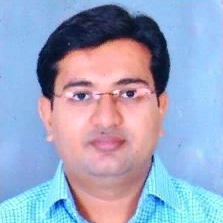
Kapil S. Raviya
Work place: C. U. Shah University, Electronics Communication Engineering, Wadhwan City, 363030, India
E-mail: raviyakapil@gmail.com
Website:
Research Interests: Digital Library, Image Processing, Computer systems and computational processes
Biography
Mr. Kapil S. Raviya has completed his bachelor and masters degree in the Electronics & Communication Engineering from Saurashtra University and Gujarat Technological University Gujarat, India and he is currently pursuing his Ph.D. in the same discipline from C. U. Shah University, Wadhwan, Gujarat. His Area of research is image processing and computer vision system. He is currently working as an assistant professor in the department of Electronics & Communication Engineering at C.U Shah College of Engineering and Technology. He has presented 4 national and international papers and published 20 international papers. He has published a book titled ―Performance Evaluation of Disparity Map of Stereo Images‖ in Lambart Publishing house, Germany. He has attended/presented/organized 23 STTP/Workshops/Training/Paper/Poster/Seminar tech. events. He has guided and examined 4 M. Tech. dissertations. He is a life member of Indian Society for Technical Education (ISTE, New Delhi) and student member of IEEE. His area of interest is Image and Video Processing, Digital Signal Processing.
Author Articles
Real Time Depth Data Refurbishment in Frequency Domain and 3D Modeling Map Using Microsoft Kinect Sensor
By Kapil S. Raviya Dwivedi Ved Vyas Ashish M. Kothari
DOI: https://doi.org/10.5815/ijigsp.2016.11.07, Pub. Date: 8 Nov. 2016
The present decade has seen the growth of both, the software and hardware for three dimensional televisions in real time applications. Depth map is fundamental key of 3-Dimensional algorithms. Reliable depth map is an acceptance in 3D transmission, analysis and compression of algorithm. Computer vision and pattern recognition research fields use sensor like low cost Microsoft kinect. Kinect sensor suffers from some problems of noise, poor accuracy and unmatched edges. This paper presents effective solution to improve the real time depth sequences and real time 3-D map using warping method from kinect sensor.
We proposed real time frequency domain based depth data refurbishment and improve the quality of depth video provided by sensors' Microsoft Kinect. The quality of the depth map is improved by depth refurbishment in frequency domain technique, filling the holes present in the maps, 2-Dimensional spatial filtering and permutation of morphological operation. We show that the proposed approach is able to generate high quality depth maps which can be quite useful in improving the performance of various applications of Microsoft Kinect such as obstacle detection and avoidance, pose estimation, gesture recognition, skeletal and facial tracking, etc. We produce the real time 3-D map using warping method. An experimental result shows that the quality of our proposed method is better than previous research works. Our algorithm produces noise less, reliable, smooth and efficient depth sequence. The qualitative parameter Peak Signal to Noise Ratio (PSNR), Structure Similarity Index Map (SSIM) and Mean Square Error (MSE) measure the real time results for comparative analysis.
An Evaluation and Improved Matching Cost of Stereo Matching Method
By Kapil S. Raviya Dwivedi Ved Vyas Ashish M. Kothari
DOI: https://doi.org/10.5815/ijigsp.2016.10.06, Pub. Date: 8 Oct. 2016
The main target of stereo matching algorithms is to find out the three dimensional (3D) distance, or depth of objects from a stereo pair of images. Depth information can be derived from images using disparity map of the same scene. There are many applications of computer vision like People tracking, Gesture recognition, Industrial automation and inspection, Security and Biometrics, Three-dimensional modeling, Web and Cloud, Aerial surveys etc. There are large categories of stereo algorithms which are used for finding the disparity or depth. This paper presents a proposed stereo matching algorithm to obtain depth map, enhance and measure. The hybrid mathematical process of the algorithm are color conversion, block matching, guided filtering, Minimum disparity assignment design, mathematical perimeter, zero depth assignment, combination of hole filling and permutation of morphological operator and last non linear spatial filtering. Our algorithm is produce noise less, reliable, smooth and efficient depth map. We obtained the results with ground truth image using Structural Similarity Index Map (SSIM) and Peak Signal to Noise Ratio (PSNR).
[...] Read more.Other Articles
Subscribe to receive issue release notifications and newsletters from MECS Press journals